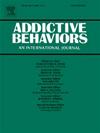Flavored combustible tobacco product initiation in two longitudinal youth cohorts in the US Population Assessment of Tobacco and Health Study: 2013–2016 and 2016–2019
IF 3.7
2区 医学
Q1 PSYCHOLOGY, CLINICAL
引用次数: 0
Abstract
Introduction
Flavored tobacco products increase appeal and lower barriers to nicotine addiction for young people. We compared environmental, psychosocial, behavioral, and demographic characteristics between youth who started with flavored and non-flavored (i.e., tobacco-flavored) combustible tobacco products (CTPs).
Methods
We analyzed two representative US youth cohorts (baseline age 12–15) from the Population Assessment of Tobacco and Health (PATH) Study (Wave 1 Cohort (W1) 2013–2016; Wave 4 Cohort (W4) 2016–2019). We first assessed baseline characteristics associated with any subsequent CTP initiation among youth with baseline never CTP use (W1 n=5,946; W4 n=8,240). Then, for baseline CTP-naïve youth with subsequent CTP initiation (new experimentation; W1 n=519; W4 n=538), we assessed baseline characteristics associated with subsequent initiation with flavored CTPs versus non-flavored.
Results
Most youth reporting new CTP experimentation initiated with flavored CTPs (W1:67.8%; W4:74.2%). Household norms, susceptibility, baseline experimentation with vaping, alcohol, and/or cannabis; and White race were associated with CTP experimentation. For both cohorts, frequent social media use was associated with flavored CTP initiation (W4 AOR:2.50, 95%CI:1.22,5.12) and Black youth (W4 AOR:0.12, 95%CI:0.06,0.25) were less likely to initiate with flavored CTPs than White youth. Among W1 Cohort youth, perceiving flavored product use as easier was positively associated with flavored CTP initiation (AOR:1.48, 95%CI:1.01,2.17). Among W4 Cohort youth, baseline vaping was negatively associated with flavored CTP initiation (AOR:0.10, 95%CI:0.05,0.20).
Conclusion
Frequent social media use was associated with flavored CTP initiation among youth who used CTPs. Youth who had ever vaped and Black youth were less likely to initiate with flavored CTPs.
美国烟草与健康人群评估研究:2013-2016 年和 2016-2019 年两个纵向青少年队列中调味可燃烟草制品的使用情况。
导言:风味烟草制品增加了对青少年的吸引力并降低了尼古丁成瘾的障碍。我们比较了开始使用有香味和无香味(即烟草香味)可燃烟草制品(CTPs)的青少年的环境、社会心理、行为和人口特征:我们分析了烟草与健康人群评估(PATH)研究中两个具有代表性的美国青少年队列(基线年龄为 12-15 岁)(2013-2016 年第 1 波队列(W1);2016-2019 年第 4 波队列(W4))。我们首先评估了基线从未使用过 CTP 的青少年(W1 n=5,946; W4 n=8,240)中与随后开始使用 CTP 相关的基线特征。然后,对于基线从未使用过 CTP 但随后开始使用 CTP 的青少年(新尝试;W1 n=519;W4 n=538),我们评估了随后开始使用有味 CTP 与无味 CTP 的相关基线特征:结果:大多数报告新尝试 CTP 的青少年都开始使用有味 CTP(W1:67.8%;W4:74.2%)。家庭规范、易感性、尝试吸食电子烟、酒精和/或大麻的基线以及白种人与尝试 CTP 有关。在两个队列中,频繁使用社交媒体与开始吸食有味 CTP 相关(W4 AOR:2.50,95%CI:1.22,5.12),黑人青少年(W4 AOR:0.12,95%CI:0.06,0.25)开始吸食有味 CTP 的可能性低于白人青少年。在 W1 组群的青少年中,认为使用风味产品更容易与开始使用风味 CTP 呈正相关(AOR:1.48, 95%CI:1.01,2.17)。在W4队列的青少年中,基线吸烟与开始使用加味CTP呈负相关(AOR:0.10,95%CI:0.05,0.20):结论:在使用 CTPs 的青少年中,频繁使用社交媒体与开始使用有味 CTPs 有关。曾经吸食过烟草的青少年和黑人青少年开始吸食加味 CTP 的可能性较低。
本文章由计算机程序翻译,如有差异,请以英文原文为准。
求助全文
约1分钟内获得全文
求助全文
来源期刊

Addictive behaviors
医学-药物滥用
CiteScore
8.40
自引率
4.50%
发文量
283
审稿时长
46 days
期刊介绍:
Addictive Behaviors is an international peer-reviewed journal publishing high quality human research on addictive behaviors and disorders since 1975. The journal accepts submissions of full-length papers and short communications on substance-related addictions such as the abuse of alcohol, drugs and nicotine, and behavioral addictions involving gambling and technology. We primarily publish behavioral and psychosocial research but our articles span the fields of psychology, sociology, psychiatry, epidemiology, social policy, medicine, pharmacology and neuroscience. While theoretical orientations are diverse, the emphasis of the journal is primarily empirical. That is, sound experimental design combined with valid, reliable assessment and evaluation procedures are a requisite for acceptance. However, innovative and empirically oriented case studies that might encourage new lines of inquiry are accepted as well. Studies that clearly contribute to current knowledge of etiology, prevention, social policy or treatment are given priority. Scholarly commentaries on topical issues, systematic reviews, and mini reviews are encouraged. We especially welcome multimedia papers that incorporate video or audio components to better display methodology or findings.
Studies can also be submitted to Addictive Behaviors? companion title, the open access journal Addictive Behaviors Reports, which has a particular interest in ''non-traditional'', innovative and empirically-oriented research such as negative/null data papers, replication studies, case reports on novel treatments, and cross-cultural research.
 求助内容:
求助内容: 应助结果提醒方式:
应助结果提醒方式:


